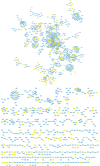Identifying Early Warning Signals for the Sudden Transition from Mild to Severe Tobacco Etch Disease by Dynamical Network Biomarkers
- PMID: 31861938
- PMCID: PMC7019593
- DOI: 10.3390/v12010016
Identifying Early Warning Signals for the Sudden Transition from Mild to Severe Tobacco Etch Disease by Dynamical Network Biomarkers
Abstract
Complex systems exhibit critical thresholds at which they transition among alternative phases. Complex systems theory has been applied to analyze disease progression, distinguishing three stages along progression: (i) a normal noninfected state; (ii) a predisease state, in which the host is infected and responds and therapeutic interventions could still be effective; and (iii) an irreversible state, where the system is seriously threatened. The dynamical network biomarker (DNB) theory sought for early warnings of the transition from health to disease. Such DNBs might range from individual genes to complex structures in transcriptional regulatory or protein-protein interaction networks. Here, we revisit transcriptomic data obtained during infection of tobacco plants with tobacco etch potyvirus to identify DNBs signaling the transition from mild/reversible to severe/irreversible disease. We identified genes showing a sudden transition in expression along disease categories. Some of these genes cluster in modules that show the properties of DNBs. These modules contain both genes known to be involved in response to pathogens (e.g., ADH2, CYP19, ERF1, KAB1, LAP1, MBF1C, MYB58, PR1, or TPS5) and other genes not previously related to biotic stress responses (e.g., ABCI6, BBX21, NAP1, OSM34, or ZPN1).
Keywords: DNB; Potyvirus; Tobacco etch virus; complex systems; phase transitions; plant-virus interaction; protein-protein interaction networks; response to infection; systems biology.
Conflict of interest statement
The authors declare no conflict of interest. The funders had no role in the design of the study; in the collection, analyses, or interpretation of data; in the writing of the manuscript; or in the decision to publish the results.
Figures






Similar articles
-
Interaction network of tobacco etch potyvirus NIa protein with the host proteome during infection.BMC Genomics. 2016 Feb 1;17:87. doi: 10.1186/s12864-016-2394-y. BMC Genomics. 2016. PMID: 26830344 Free PMC article.
-
Mutation of a Short Variable Region in HCpro Protein of Potato virus A Affects Interactions with a Microtubule-Associated Protein and Induces Necrotic Responses in Tobacco.Mol Plant Microbe Interact. 2013 Jul;26(7):721-33. doi: 10.1094/MPMI-01-13-0024-R. Mol Plant Microbe Interact. 2013. PMID: 23514111
-
Detecting tissue-specific early warning signals for complex diseases based on dynamical network biomarkers: study of type 2 diabetes by cross-tissue analysis.Brief Bioinform. 2014 Mar;15(2):229-43. doi: 10.1093/bib/bbt027. Epub 2013 Apr 25. Brief Bioinform. 2014. PMID: 23620135
-
A systems biology approach to the evolution of plant-virus interactions.Curr Opin Plant Biol. 2011 Aug;14(4):372-7. doi: 10.1016/j.pbi.2011.03.013. Epub 2011 Mar 30. Curr Opin Plant Biol. 2011. PMID: 21458360 Review.
-
Fast forward genetics based on virus-induced gene silencing.Curr Opin Plant Biol. 1999 Apr;2(2):109-13. doi: 10.1016/S1369-5266(99)80022-3. Curr Opin Plant Biol. 1999. PMID: 10322199 Review.
Cited by
-
Trehalose metabolism coordinates transcriptional regulatory control and metabolic requirements to trigger the onset of cassava storage root initiation.Sci Rep. 2023 Nov 15;13(1):19973. doi: 10.1038/s41598-023-47095-8. Sci Rep. 2023. PMID: 37968317 Free PMC article.
-
Special Issue: "The Complexity of the Potyviral Interaction Network".Viruses. 2020 Aug 11;12(8):874. doi: 10.3390/v12080874. Viruses. 2020. PMID: 32796503 Free PMC article.
-
Adaptation of turnip mosaic virus to Arabidopsis thaliana involves rewiring of VPg-host proteome interactions.Virus Evol. 2024 Jul 16;10(1):veae055. doi: 10.1093/ve/veae055. eCollection 2024. Virus Evol. 2024. PMID: 39091990 Free PMC article.
-
Synchrony of biomarker variability indicates a critical transition: Application to mortality prediction in hemodialysis.iScience. 2022 May 10;25(6):104385. doi: 10.1016/j.isci.2022.104385. eCollection 2022 Jun 17. iScience. 2022. PMID: 35620427 Free PMC article.
References
-
- Gilmore R. Catastrophe Theory for Scientists and Engineers. Dover; New York, NY, USA: 1981.
Publication types
MeSH terms
Substances
LinkOut - more resources
Full Text Sources
Research Materials

